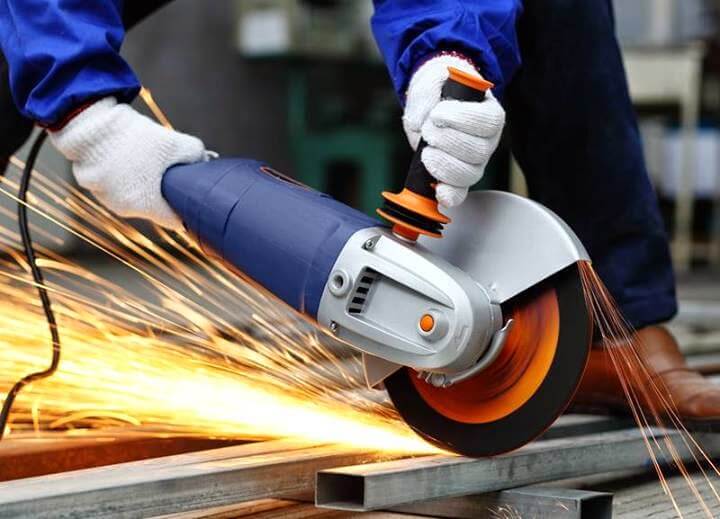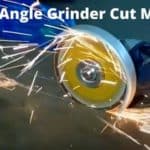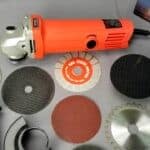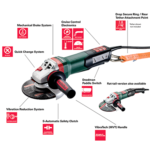There are a few key differences between grinders and angle grinders that you should know before deciding which type of tool is right for your project. Grinders are designed for use with materials that are softer, such as plastic or metal, and angle grinders are better suited for tougher materials like stone or concrete. Angle grinders also have a higher speed than grinders, which means they can cut through material faster.
There are a lot of different power tools on the market, and it can be hard to know which one is right for the job. If you’re looking for a tool to help with grinding and cutting, you might be wondering if a grinder or an angle grinder is the better option. Here’s a look at the key differences between grinders and angle grinders to help you make the best decision for your needs.
Grinders are typically smaller and more lightweight than angle grinders. They’re also usually cheaper. Grinders are ideal for smaller jobs like removing rust from metal or sharpening lawnmower blades.
Angle grinders, on the other hand, are larger and more powerful. They’re better suited for bigger jobs like cutting concrete or tile. Angle grinders can also be fitted with different attachments for different tasks.
So, which is the better option? It really depends on the job you need to do. If you’re working on something small, a grinder will probably do the trick.
For bigger jobs, an angle grinder is the way to go.
Operated Angle Grinder vs Shredder! Amazing Experiment!
What is Difference between Grinder And Angle Grinder?
An angle grinder is a power tool that is typically used for grinding and abrasive cutting applications. On the other hand, a grinder is a machine tool that is used for grinding purposes. Both angle grinders and grinders can be used for a variety of different applications, but there are some key differences between the two.
For starters, angle grinders are typically handheld power tools, while grinders are stationary. This means that angle grinders are more portable and can be used in a variety of different settings. Grinders, on the other hand, are usually used in industrial settings and are not as portable.
Another key difference between angle grinders and grinders is the type of power source. Angle grinders typically use an electric motor, while grinders may use either an electric motor or a diesel engine.
Finally, angle grinders typically have a much higher speed than grinders.
This means that they can be used for a wider range of applications, such as grinding metal or cutting stone. Grinders, on the other hand, are typically used for more specific applications, such as polishing wood or shaping metal.
Why is a Grinder Called an Angle Grinder?
An angle grinder is a handheld power tool that is used for grinding, polishing, and cutting. The name “angle grinder” is derived from the fact that the tool is held at an angle to the work surface. Angle grinders are available in a variety of sizes and styles, and can be used for a variety of purposes.
The most common use for an angle grinder is to grind down metal or concrete. The grinding wheel is made of abrasive material that wears down as it grinds. The angle grinder can also be used to cut metal or concrete, using a cutting wheel.
Angle grinders are also used for polishing and buffing. The polishing wheel is made of a softer material than the grinding wheel, and it polishes the surface as it rotates.
Angle grinders are available with different power levels, from small, handheld models to large, powerful machines.
The size and power of the angle grinder will be determined by the task it will be used for.
What is an Angle Grinder Best Used For?
An angle grinder is a handheld power tool that can be used for a variety of different applications. The most common use for an angle grinder is grinding metal, but it can also be used to cut tile, stone, or concrete. Angle grinders use a variety of different sized discs, which are made from different materials such as metal, stone, or concrete.
The size of the disc will determine the size of the angle grinder that you will need. The most common sizes are 4.5″, 5″, and 6″. Angle grinders are also available in cordless versions, which can be very handy if you need to use the tool in tight spaces or if you need to move around a lot.
Can an Angle Grinder Cut Through Anything?
An angle grinder is a powerful hand-held power tool that can be used for a variety of different applications. While it is most commonly used for grinding metal, it can also be used for cutting, sanding, and polishing. So, can an angle grinder cut through anything?
The answer is no, an angle grinder cannot cut through everything. While it is a powerful tool, it is not designed to cut through all materials. The most common material that an angle grinder is used to cut is metal, but it can also be used to cut stone, tile, concrete, and even plastic.
When choosing an angle grinder, be sure to select one that is appropriate for the material you will be cutting. For example, if you are looking to cut metal, you will want to choose a model that has a higher power rating and a metal cutting disc. If you are looking to cut stone or tile, you will want to choose a model with a lower power rating and a stone cutting disc.
If you are unsure of what model to choose, or what type of disc to use, be sure to ask a professional at your local hardware store for advice.

Credit: heckhome.com
Best Angle Grinder
An angle grinder is a handheld power tool that can be used for a variety of applications, including grinding, cutting, and polishing. Angle grinders are a versatile tool that can be used for a variety of projects, such as removing rust from metal, cutting tile, or polishing stone. While angle grinders can be a helpful tool, it’s important to use them safely.
This guide will provide you with everything you need to know about angle grinders, including how to choose the best one for your project and how to use it safely.
When choosing an angle grinder, the most important factor to consider is the size of the grinder. Angle grinders come in a variety of sizes, from small handheld models to large floor-standing models.
The size of the grinder you need will depend on the projects you plan to use it for. If you only need a grinder for occasional small projects, a handheld model will suffice. For larger projects, or if you plan to use the grinder frequently, a floor-standing model will be a better option.
Another important factor to consider when choosing an angle grinder is the speed. Angle grinders are available in both variable speed and single speed models. Variable speed models allow you to adjust the speed of the grinder to match the project you’re working on.
This is a helpful feature if you’re working with a variety of materials. Single speed models are typically less expensive, but they only operate at one speed. This can be a downside if you’re working with materials that require different speeds.
Once you’ve selected the right angle grinder for your project, it’s important to use it safely. Always wear protective gear, including gloves, goggles, and a dust mask. Be sure to keep the grinder’s guard in place and never remove it.
When using the grinder, hold it firmly with both hands and keep your fingers away from the spinning wheel. Avoid using the grinder in wet or damp conditions, as this can increase the risk of injury.
Angle grinders are a versatile and powerful tool, but it’s important to use them safely. Be sure to choose the right model for your project and follow all safety precautions.
Angle Grinder Vs Cut-Off Tool
An angle grinder is a handheld power tool that can be used for a variety of different projects, including grinding, cutting, and polishing. A cut-off tool, on the other hand, is a power tool that is specifically designed for cutting through materials. So, what’s the difference between an angle grinder and a cut-off tool?
An angle grinder is a versatile tool that can be used for a variety of different applications, including grinding, cutting, and polishing. A cut-off tool, on the other hand, is specifically designed for cutting through materials. The main difference between an angle grinder and a cut-off tool is the size of the blade or cutting disc.
Angle grinders have larger blades or cutting discs, which makes them ideal for larger projects. Cut-off tools have smaller blades or cutting discs, which makes them better suited for smaller projects.
Another difference between an angle grinder and a cut-off tool is the speed at which they operate.
Angle grinders typically have higher speeds, which makes them better for larger projects. Cut-off tools typically have lower speeds, which makes them better suited for smaller projects.
So, which tool is right for your project?
If you’re working on a large project, then an angle grinder is the better choice. If you’re working on a smaller project, then a cut-off tool is the better choice.
What is a Die Grinder Vs Dremel
There are many die grinders on the market, but the Dremel is by far the most popular. So, what is a die grinder, and what sets it apart from other grinders?
A die grinder is a handheld power tool that uses an abrasive wheel to grind down surfaces.
It’s similar to a rotary tool, but it’s more powerful and can handle tougher jobs. Die grinders are often used to remove rust or paint from metal surfaces, or to grind away welds.
What makes the Dremel so popular is its versatility.
It can be used for a wide variety of grinding, sanding, and polishing tasks. It’s also relatively affordable, and it’s easy to find replacement parts and accessories.
If you’re looking for a powerful and versatile grinder, the Dremel is a great choice.
It can handle most grinding and sanding tasks, and it’s easy to use. Just be sure to wear eye and ear protection, and follow the manufacturer’s safety instructions.
Disc Grinder
A disc grinder, also called a side grinder or angle grinder, is a handheld power tool used for grinding (abrasive cutting) and polishing. Disc grinders are relatively small hand-held tools, but can be very dangerous if used improperly. Due to the high speed of the disc, if the grinder is held in the wrong position or the operator does not have proper control, the disc can easily break and cause serious injury.
Disc grinders are most commonly used to remove excess material from a workpiece, to smooth or finish a surface, or to remove rust or paint. When choosing a disc grinder, it is important to select the correct disc for the material being removed and the desired finish. For example, a softer disc should be used on softer materials such as aluminum, while a harder disc is better suited for harder materials such as steel.
Disc grinders can be powered by electricity, compressed air, or batteries, and are available in a variety of sizes and power levels. Smaller, handheld units are typically used for light-duty grinding, while larger, more powerful units are used for heavy-duty grinding.
Angle Grinder Uses
An angle grinder is a powerful tool that can be used for a variety of different projects. Here are some of the most common uses for an angle grinder:
1. Cutting tile, stone, or concrete: Angle grinders are equipped with abrasive discs that can quickly cut through hard materials like tile, stone, or concrete.
2. Grinding metal: Angle grinders can be used to remove rust or paint from metal surfaces. They can also be used to grind down metal to create a smooth surface.
3. Sharpening blades: Angle grinders can be used to sharpen dull blades, such as those on a lawn mower or chainsaw.
4. Removing welds: Angle grinders can be used to remove welding beads from metal surfaces.
5. Polishing: Angle grinders can be used with polishing pads to create a high-shine finish on metal or stone surfaces.
Die Grinder Vs Drill
A die grinder is a versatile tool that can be used for a variety of tasks, from grinding to polishing. Die grinders are available in a variety of sizes and styles to suit any need.
Drills, on the other hand, are designed for one specific purpose: drilling holes.
While a drill can be used to grind and polish, it is not as effective as a die grinder. When choosing between a die grinder and a drill, it is important to consider the intended use.
Die grinders are ideal for tasks that require a high degree of precision, such as grinding, polishing, and carving.
They are also well-suited for work in tight spaces. Drills, on the other hand, are better suited for tasks that require more power, such as drilling holes.
Dewalt Angle Grinder
If you’re looking for a high-quality angle grinder, you can’t go wrong with a Dewalt. This brand is known for making durable, powerful tools that can tackle a variety of projects. Whether you need to cut through metal or grind down a rough surface, a Dewalt angle grinder will get the job done quickly and efficiently.
There are a few things to keep in mind when shopping for a Dewalt angle grinder. First, you’ll need to decide between a corded and cordless model. Corded models are more powerful, but they require an outlet to operate.
Cordless models are more convenient, but they may not have as much power.
Next, you’ll need to decide what size grinder you need. Dewalt offers a variety of sizes, from small handheld models to large floor-standing units.
Choose the size that best suits your needs.
Finally, you’ll need to decide on the features you want. Some angle grinders come with built-in dust collectors, while others have adjustable speed settings.
Choose the features that will make your job easier and more efficient.
No matter what your needs, there’s a Dewalt angle grinder that’s perfect for the job. With a variety of models and sizes to choose from, you’re sure to find the perfect tool for your next project.
Angle Die Grinder
An angle die grinder is a versatile tool that can be used for a variety of projects. Here are some tips on how to use an angle die grinder:
• Choose the right attachment for your project.
Angle die grinders come with a variety of attachments, including grinding wheels, sanding discs, and polishing pads. Select the attachment that is best suited for your project.
• Be sure to wear safety glasses when using an angle die grinder.
The grinding wheel can create sparks and debris that can be dangerous to your eyes.
• Use the angle die grinder at a low speed when first starting your project. You can increase the speed as you become more comfortable with the tool.
• Hold the angle die grinder firmly with both hands when in use. This will help to prevent the tool from becoming overloaded and damaging the work piece.
Angle die grinders are a versatile tool that can be used for a variety of projects.
By following these tips, you can use an angle die grinder safely and effectively.
Conclusion
If you’re wondering whether to use a grinder or an angle grinder for your next project, then you’ll want to know the difference between the two tools. Grinders are designed for grinding and finishing applications, while angle grinders are designed for cutting and grinding applications. Here’s a closer look at the key differences between grinders and angle grinders:
Grinders:
-Are designed for grinding and finishing applications
-Have a cylindrical shape
-Work best on softer materials
-Can be used for rapid removal of material
Angle Grinders:
-Are designed for cutting and grinding applications
-Have a disk-shaped grinding head
-Work best on harder materials
-Can be used for precision grinding
So, which tool is best for your next project? If you need to remove material quickly, then a grinder is the best choice.
If you need to cut or grind hard materials, then an angle grinder is the better option.

Hi, this is Cynthia A. Rose. Welcome to my Grinder related blog. Usually, I am busy with my kitchen and cooking all day. My main desire is to create a new recipe every day. But I have to use new tools every day to create new recipes. In this blog, I will share you how to use kitchen tools properly. I will not just share cooking related equipment, I will try to review all kinds of grinders like angle grinder among you. I hope my 12 years of experience will come in handy. Thanks!





